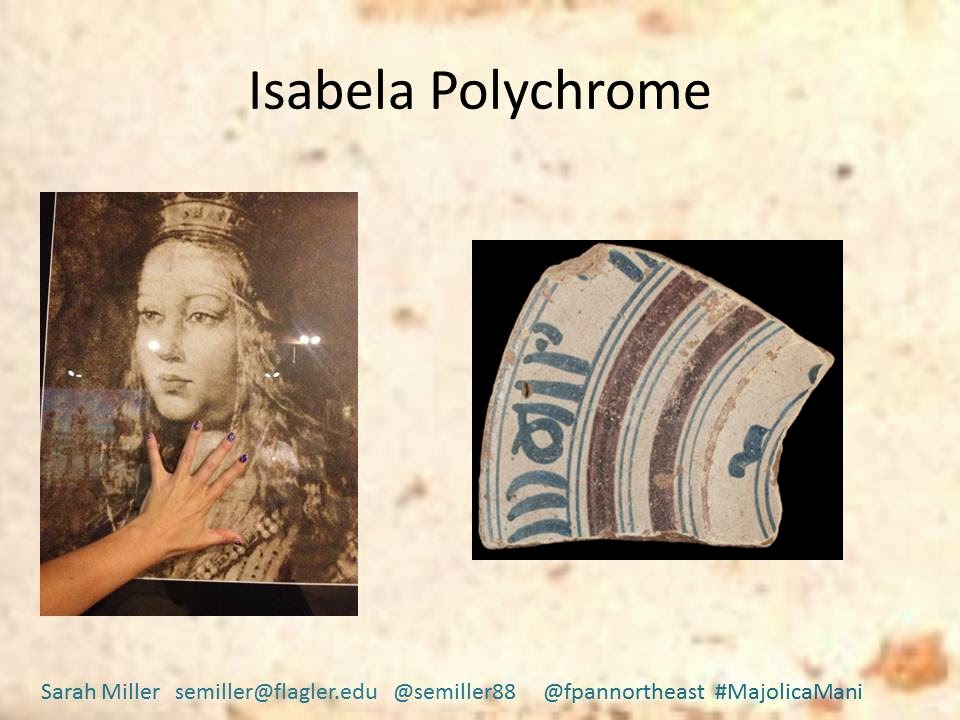More Majolica Manicures: Isabela Polychrome
When the Florida Anthropological Society came into town for the annual conference in 2013 I knew I had to do something special. Inspired by Isabela Polychrome, I set out to do a blue, white, and purple manicure with bands and geometric designs.
You may remember my previous post on majolica Morisco wares:
Isabela is one of my absolutely favorite types. I love it so much, I
made a manicure inspired by the color and design elements. Isabela has
the same base paste as Columbia and features the twin blue bands on rim
and base like Yayal, but the addition of purple glaze is a dead
giveaway. It's the only polychrome Morisco ware and the only historic
majolica to feature the color purple. The designs can be floral,
abstract, and geometric. I sometimes confuse it with Yayal or Santo
Domingo when I don't recognize the blackish schmear on the rim is not
tar, but actually think purple glaze. But generally it's easy to pick
out.
Another reason to love Isabela? Vessels often feature Alafias,
common Arabic sayings, on the rims. According to the FLMNH page the
Alafias commonly translate to mercy, pardon, pity, or well-being. A
great cultural connection to 16th century Muslim traditions and changes
in Spain from a single sherd.
- See more at: http://fpangoingpublic.blogspot.com/2014/07/ceramics-101-majolica-morisco-tradition.html#sthash.f55YLxBR.dpuf
Isabela is one of my absolutely
favorite types. I love it so much, I made a manicure inspired by the
color and design elements. Isabela has the same base paste as Columbia
and features the twin blue bands on rim and base like Yayal, but the addition
of purple glaze is a dead giveaway. It's the only polychrome Morisco ware
and the only historic majolica to feature the color purple. The designs
can be floral, abstract, and geometric. I sometimes confuse it with Yayal
or Santo Domingo when I don't recognize the blackish schmear on the rim is not
tar, but actually think purple glaze. But generally it's easy to pick
out.
Another reason to love
Isabela? Vessels often feature Alafias, common Arabic
sayings, on the rims. According to the FLMNH page the Alafias commonly
translate to mercy, pardon, pity, or well-being. A great cultural
connection to 16th century Muslim traditions and changes in Spain from a single
sherd.
As per usual I began by looking at the Florida Museum of Natural History's digital type collection to view all examples on Isabela Polychrome. I also pulled up photos from Kathy Deagan's class of sherds we looked at in class. From there I applied a thin white base coat to mimic the Colombia Plain glaze and background over what would be a thick, white, coarse earthenware paste.
Examples from FLMNH Digital Type Collection (left), examples from class (right).
From there I tried my best to match the cobalt blue and deep purple. Sometimes in the field I mistake Isabela because the purple looks more like a black schmear of something that shouldn't be there. But on other examples that beautiful manganese derived purple comes through. Isabela is the only colonial Spanish sherd that has purple featured on the handpainted decoration. Later French and British sherds have manganese sponging or much later transfer printed purple designs. I was surprised to find so many geometric examples, and of course the Arabic Alafia's had to be incorporated. Here was the result:
The photo at the top of the page was taken during a reception at the Fountain of Youth Archaeological Park where they had Queen Isabel's portrait. Quite appropriate as they have found Isabela during the digs of Menendez's 1565 landing site out at the Fountain of Youth. It also popped up last week in Carl's dig at the St. Augustine Art Association (check out the news coverage!).
For more #MajolicaMani posts check out:
- Aucilla Polychrome (1650-1700)
- San Elizario (1750-1800)
- San Luis Polychrome 1650-1750*
- Abo Polychrome 1650-1725*
- Puebla Polychrome 1650-1725*
- FAN NAIL! Faince (18th C)*
- Pensacola Striped c. 1725
For more #MajolicaMani posts check out:
*Initial Feb 2013 posting Majolica Manies - See more at: http://fpangoingpublic.blogspot.com/2014/07/more-majolica-manicures-aucilla.html#sthash.4yKbqcsx.dpuf
*Initial Feb 2013 posting Majolica Manies - See more at: http://fpangoingpublic.blogspot.com/2014/07/more-majolica-manicures-aucilla.html#sthash.4yKbqcsx.dpuf
For more #MajolicaMani posts check out:
*Initial Feb 2013 posting Majolica Manies - See more at: http://fpangoingpublic.blogspot.com/2014/07/more-majolica-manicures-aucilla.html#sthash.4yKbqcsx.dpuf
*Initial Feb 2013 posting Majolica Manies - See more at: http://fpangoingpublic.blogspot.com/2014/07/more-majolica-manicures-aucilla.html#sthash.4yKbqcsx.dpuf
For more #MajolicaMani posts check out:
*Initial Feb 2013 posting Majolica Manies - See more at: http://fpangoingpublic.blogspot.com/2014/07/more-majolica-manicures-aucilla.html#sthash.4yKbqcsx.dpuf
*Initial Feb 2013 posting Majolica Manies - See more at: http://fpangoingpublic.blogspot.com/2014/07/more-majolica-manicures-aucilla.html#sthash.4yKbqcsx.dpuf
Text and Photos: Sarah Miller, FPAN staff. - See more at: http://fpangoingpublic.blogspot.com/2014/09/majolica-manicures-pensacola-striped.html#sthash.4Guz8DeO.dpuf
Carl in his natural environment, Isabela found in the wild!
For
more #MajolicaMani posts check out:
- Pensacola Striped (1650 - 1725)
- Aucilla Polychrome (1650-1700)
- San Elizario (1750-1800)
- San Luis Polychrome 1650-1750*
- Abo Polychrome 1650-1725*
- Puebla Polychrome 1650-1725*
- FAN NAIL! Faince (18th C)*
- Pensacola Striped c. 1725
*Initial Feb 2013 posting MajolicaManies.
Text and Photos: Sarah Miller, FPAN staff.
References cited: Isabela Polychrome, Historical Archaeology Digital Type Collection, Florida Museum of Natural History.






